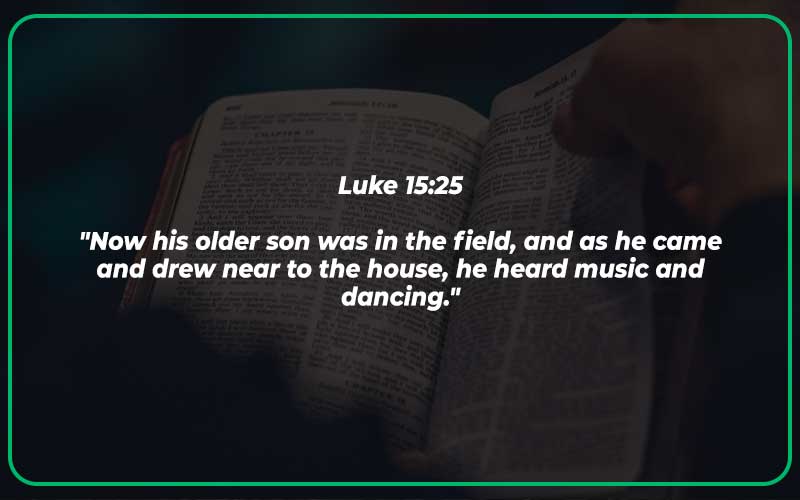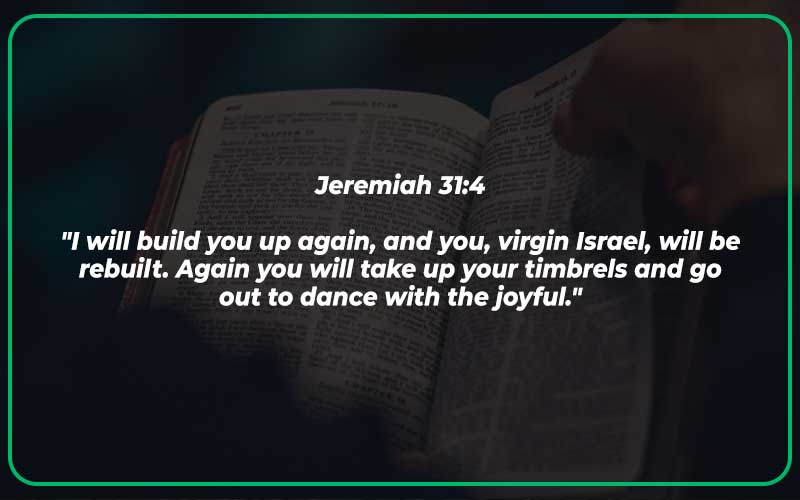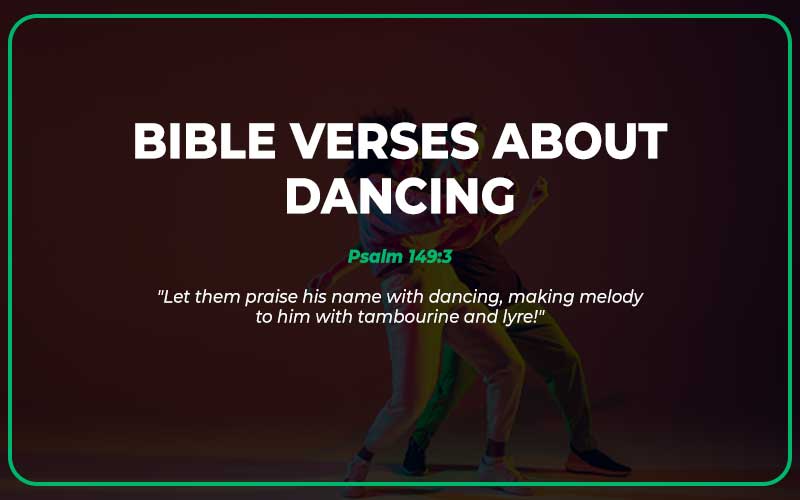Dancing is a joyful expression of the human spirit, and the Bible contains verses that celebrate the act of dancing. In this blog post, we will explore these verses, uncovering the spiritual and cultural significance of dance.
From jubilant celebrations to heartfelt worship, these verses will inspire you to let go, embrace the rhythm of life, and dance with joy before the Lord. So, put on your dancing shoes and join us on this exuberant journey through the pages of the Bible.
Also Read: Bible Verses About Seasons
Bible Verses About Dancing
Psalm 149:3
“Let them praise his name with dancing, making melody to him with tambourine and lyre!”
The psalmist encourages the use of dance as a form of praise and worship to God. Dancing expresses joy and celebration of God’s goodness and grace. It involves the whole person, engaging both the body and the spirit.
Exodus 15:20-21
“Then Miriam the prophetess, the sister of Aaron, took a tambourine in her hand, and all the women went out after her with tambourines and dancing. And Miriam sang to them: ‘Sing to the LORD, for he has triumphed gloriously; the horse and his rider he has thrown into the sea.'”
Miriam led the Israelite women in a dance to celebrate their deliverance and victory over their enemies. This scene shows that dancing was an integral part of their expression of gratitude to God.
2 Samuel 6:14-16
“And David danced before the LORD with all his might. And David was wearing a linen ephod. So David and all the house of Israel brought up the ark of the LORD with shouting and with the sound of the horn.”
David’s dance in this passage is a response to the return of the ark of the covenant to Jerusalem, which represents the presence of God. His dance expresses his joy and reverence to God.
Ecclesiastes 3:4
“…a time to weep, and a time to laugh; a time to mourn, and a time to dance;”
The author of Ecclesiastes includes dancing in the list of human experiences and emotions. It recognizes that there are certain times when dancing is appropriate and meaningful, just as there are times for sorrow and mourning.
Psalms 30:11-12
“You have turned for me my mourning into dancing; you have loosed my sackcloth and clothed me with gladness, that my glory may sing your praise and not be silent. O LORD my God, I will give thanks to you forever!”
God’s transformative power is praised in this Psalm, which speaks of the joy that results from being delivered from mourning and sadness. Dancing is a symbol of the new life and hope that comes from God’s faithfulness.
Jeremiah 31:13
“Then shall the young women rejoice in the dance, and the young men and the old shall be merry. I will turn their mourning into joy; I will comfort them, and give them gladness for sorrow.”
The prophet Jeremiah describes God’s promise of restoration, which includes a return to joy and celebration. Dancing is a part of the anticipated future of the people of Israel, a sign of healing and happiness.
Luke 15:25
“Now his older son was in the field, and as he came and drew near to the house, he heard music and dancing.”
This parable of the prodigal son includes a scene of celebration and dancing when the younger son returns home. Dancing is a symbol of the joy and forgiveness that comes from being reconciled with God and one another.

Psalms 30:1-2
“I will extol you, O LORD, for you have drawn me up and have not let my foes rejoice over me. O LORD my God, I cried to you for help, and you have healed me.”
The psalmist praises God for delivering them from their troubles and offering healing. Dancing is a fitting expression of gratitude and joy for God’s goodness and faithfulness.
Psalms 68:24-26
“Your procession is seen, O God, the procession of my God, my King, into the sanctuary – the singers in front, the musicians last, between them virgins playing tambourines: ‘Bless God in the great congregation, the LORD, O you who are of Israel’s fountain!'”
This psalm describes a religious procession, including music, singing, and dancing. It emphasizes the communal aspect of worship and the joy that comes from praising God in a group.
Psalm 30:5
“For his anger lasts only a moment, but his favor lasts a lifetime; weeping may stay for the night, but rejoicing comes in the morning.”
This Psalm speaks of the temporary nature of pain and suffering in comparison to the everlasting joy that comes from God. Dancing is a symbol of this joyful hope, a way to celebrate and express trust in God’s goodness.
Psalms 149:3-4
“Let them praise his name with dancing, making melody to him with tambourine and lyre! For the LORD takes pleasure in his people; he adorns the humble with salvation.”
This passage encourages dancing as a form of worship and praise, recognizing God’s pleasure in the fervent worship of his people. It emphasizes the humility and gratitude that should accompany our praise, recognizing the salvation that God has given us.
Psalms 87:7
“Singers and dancers alike will say, ‘All my springs are in you.'”
This psalm speaks of God’s love for Zion and the honor that comes with being a citizen of that holy city. Singing and dancing express the joy and pride that comes with belonging to God’s people.
Psalm 30:11
“You have turned for me my mourning into dancing; you have loosed my sackcloth and clothed me with gladness.”
God’s transformative power is praised in this psalm, which speaks of the joy that follows mourning and sadness. Dancing is a symbol of the new life and hope that comes from God’s faithfulness.
Ecclesiastes 3:1-8
“For everything there is a season, and a time for every matter under heaven: a time to be born, and a time to die; a time to plant, and a time to pluck up what is planted; a time to kill, and a time to heal; a time to break down, and a time to build up; a time to weep, and a time to laugh; a time to mourn, and a time to dance…”
This well-known passage speaks of the various seasons of life and the emotions and experiences that accompany them. Dancing is included as a sign of joy and celebration that is appropriate in its own time and place.
Psalm 30:1
“I will extol you, O LORD, for you have drawn me up and have not let my foes rejoice over me.”
This psalm expresses gratitude for deliverance from enemies and praises God’s power and faithfulness. Dancing is a natural expression of joy and gratitude for deliverance and salvation.
Psalms 149:1
“Praise the LORD! Sing to the LORD a new song, his praise in the assembly of the godly!”
The psalmist calls for a new expression of worship, including singing and dancing, which acknowledges and celebrates God’s greatness and goodness.
Psalm 68:25
“In front are the singers, after them the musicians; with them are the young women playing the timbrels.”
This verse describes a procession of worshipers, including music and dance, as they enter the sanctuary. It portrays the joy and enthusiasm that is appropriate in worshiping God.
Psalms 150:4
“Praise him with tambourine and dance; praise him with strings and pipe!”
This verse encourages the use of dance as a form of praise and worship, along with other musical instruments. Dancing expresses joy and celebration of God’s goodness and grace.
2 Samuel 6:14
“And David danced before the LORD with all his might. And David was wearing a linen ephod.”
This scene portrays David’s enthusiastic and energetic dance as he brings the ark of the covenant to Jerusalem. It expresses his joy and reverence to God’s presence.
Jeremiah 31:4
“I will build you up again, and you, virgin Israel, will be rebuilt. Again you will take up your timbrels and go out to dance with the joyful.”
This prophetic text speaks of the restoration and renewal of Israel, accompanied by dancing and joy. It emphasizes the communal aspect of worship and the joy of being restored as God’s people.

What does God say about dancing in the Bible?
The Bible does not explicitly condemn or endorse dancing as a whole. Instead, it portrays dancing in different situations, some of which are approved by God, while others are criticized. The view of dancing in the Bible largely depends on the context and the motivations behind it.
Positive portrayals of dancing:
- Praise and Worship: Several instances in the Bible show dancing as a form of praise and worship to God. The book of Psalms, in particular, contains several examples of dancing in the context of joyful worship (Psalm 149:3, Psalm 150:4). King David, known for his strong devotion to God, danced before the Lord with all his might when bringing the Ark of the Covenant back to Jerusalem (2 Samuel 6:14).
- Celebrations: Dancing was a common expression of joy and celebration in ancient times. When the Israelites triumphed over their enemies, such as after crossing the Red Sea (Exodus 15:20) or defeating Goliath (1 Samuel 18:6), they engaged in celebratory dancing.
- Thanksgiving: Dancing was also used as a way to express gratitude to God. Miriam led the women of Israel in dancing and singing after the miraculous crossing of the Red Sea (Exodus 15:20-21).
Negative portrayals of dancing:
- Idolatry: Dancing associated with idol worship and pagan rituals is consistently condemned in the Bible. For instance, the Israelites engaged in dancing around the golden calf, which led to their disobedience and God’s anger (Exodus 32:19-25).
- Sensual and Immoral Dancing: Certain instances of dancing in the Bible are linked to immoral or seductive behavior. The story of Herodias’s daughter dancing before Herod and demanding John the Baptist’s head on a platter is a tragic example of dancing being used for nefarious purposes (Matthew 14:6-11).
What does dancing represent in the Bible?
Dancing in the Bible symbolizes a range of emotions and actions, depending on the context. Some of the significant representations of dancing include:
- Joy and Celebration: Dancing is often associated with expressions of joy and celebration in the Bible. It symbolizes exuberance and happiness, especially in moments of victory, deliverance, or gratitude towards God.
- Worship and Praise: Dancing can be a form of worship and praise to God. It serves as a physical expression of adoration, surrender, and devotion to the Almighty.
- Unity and Community: Dancing sometimes represents the unity and fellowship of a community. As people come together to dance in celebration or worship, it fosters a sense of togetherness and shared experience.
- Expression of the Spirit: In some instances, dancing is portrayed as an expression of being moved by the Holy Spirit. It can signify spiritual ecstasy and a deep connection with God.
- Warning Against Sin: On the negative side, dancing associated with sinful practices, idolatry, or immoral behavior serves as a warning against straying from God’s path and engaging in sinful activities.
Was there dancing in the Bible?
Yes, there are numerous instances of dancing recorded in the Bible, both in the Old and New Testaments. Let’s explore some notable occurrences of dancing:
- Exodus 15:20-21: After crossing the Red Sea, Miriam, the sister of Moses and Aaron, led the women of Israel in dancing and singing to celebrate their deliverance from Egypt.
- 2 Samuel 6:14-16: King David danced before the Lord with all his might when bringing the Ark of the Covenant to Jerusalem. He rejoiced in God’s presence and did not hesitate to express his praise through dance.
- Psalm 149:3: The psalmist calls for the people of God to praise Him with dancing, among other musical expressions of worship.
- Matthew 11:16-17: Jesus referred to children playing and dancing in the marketplace, highlighting the importance of understanding the context and responding appropriately.
- Luke 15:25: In the parable of the prodigal son, there is mention of music and dancing during the celebration thrown for the return of the lost son.
- Matthew 14:6-11: As mentioned earlier, the story of Herodias’s daughter dancing before Herod resulted in John the Baptist’s tragic execution.
- Jeremiah 31:13: In a beautiful prophecy, Jeremiah speaks of the restoration of Israel, describing how the young women will rejoice in dance, and their mourning will turn into joy.
These instances illustrate the diversity of dancing in the Bible, ranging from expressions of worship and joy to warnings against sinful behaviors.
In conclusion, the Bible portrays dancing in various lights, depending on the context and motivations behind it. Dancing can be a powerful and joyful form of worship and celebration when directed towards God. It becomes problematic when associated with idolatry, immorality, or sinful practices. As with all aspects of life, the Bible encourages believers to discern and engage in activities that honor and glorify God while avoiding those that lead them away from His path.

